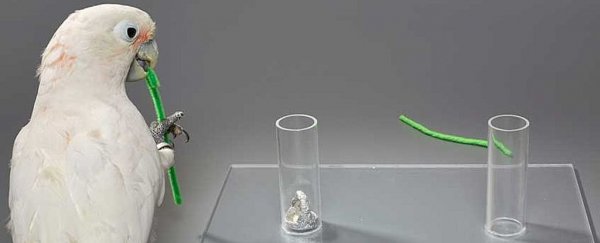Remember when crows were the big deal among tool-building animals? That's so last decade. Parrots are where it's all at now in clever avian construction.
More precisely, Goffin's cockatoo is the latest bird to be declared a master engineer by biologists. Which comes as a bit of a surprise to researchers – unlike the crow, this hook-bending cockatoo isn't known for such constructive talents in the wild, making its abilities all the more remarkable.
About 15 years ago, Betty the New Caledonian crow (Corvus moneduloides) made headlines for her ability to apparently invent tools to get her a reward of food.
The captured corvid bent wire into a hook to scoop a tasty morsel out of a tight space, demonstrating an uncanny ability to solve novel problems by shaping bespoke tools for novel tasks.
Betty's talent was celebrated at the time as a landmark discovery for animal cognition, but many have since wondered how much came down to creativity, as opposed to hard-wired neurology.
New Caledonian crows bend natural materials in their habitat in order to make nests and probe for food, making it difficult to separate specialised neurological wiring for hook-making from a more flexible system that we can liken to our own mental modelling.
Goffin's cockatoo (Cacatua goffiniana) doesn't build nests out of twigs, preferring to set up rather simple homes in the hollows of trees in its native environments of South-East Asia.
It doesn't seem to show much interest in manipulating sticks at all, in fact. Not that these aren't clever cockies.
Researchers from the University of Vienna and the Veterinary University Vienna put five female and eight male hand-raised Goffin's cockatoos to the Betty-test to see if they were up to the same challenge.
"As in the Betty studies, we confronted our animals with a vertical tube containing a reward basket with a handle and a straight piece of pipe cleaner," says researcher Isabelle Laumer from the University of Vienna.
To get the treat, the cockatoo would need to fashion a hook out of a pipe-cleaner to pull the food from the narrow cylinder.
The team also put the animals in front of a horizontal tube containing a food reward, and left a pipe-cleaner bent at right angles nearby, which needed to be straightened to be useful.
In one trial for one of the test groups, birds were also presented with pre-fashioned hooks.
None of the birds succeeded to solve either of the tests first go, but most slowly figured out a strategy to solve at least one of the challenges.
Two of the birds – named Fini and Moneypenny – were sharp enough to score a feed time after time by using their hooks, showing it was no fluke. They also became increasingly adept at fashioning their tools into better shapes.
"These findings are surprising as our cockatoos are neither specialised to tool-assisted foraging as the New Caledonian crows, nor are they bending sticks during nest construction, but breed in pre-existing tree holes," says researcher Alice Auersperg from the Messerli Research Institute in Vienna.
The fact that the tools varied so much in terms of configuration and the precise location of the bends also suggests the solutions were developed on the fly, and not the direct result of pre-programming.
To solve even these relatively simple puzzles, the cockatoos would need to be combining a number of rather complex behaviours that included behavioural flexibility, fine sensory feedback, rapid mental adaptation and a desire to explore and combine discoveries.
None of this is to take too much away from poor Betty. Sure, she probably took advantage of her mental hardware, but this kind of problem solving would still require a flexible approach to find the winning solution.
But when the birds eventually inherit the Earth again, all bets are now on the cockatoos having the technological advantage.
Sorry, crows.
This research was reported in Proceedings of the Royal Society B.
